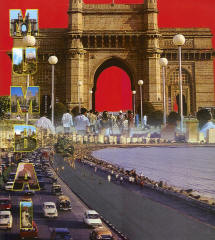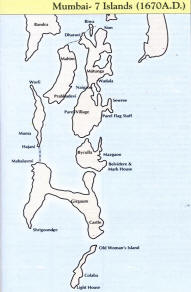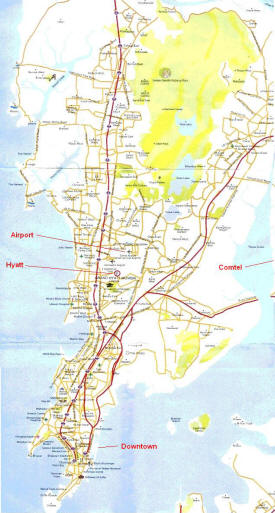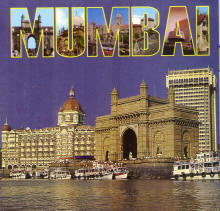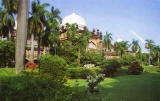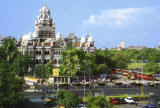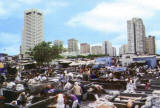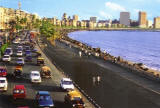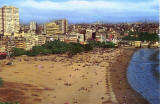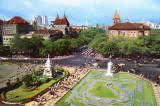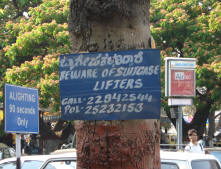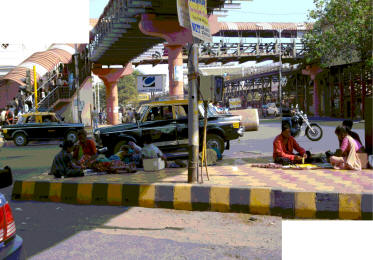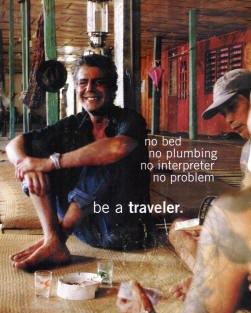 |
Passage to India Jim Dill, Mar 2007 |
I just returned from a trip to India to meet our CambridgeSoft development teams at Comtel India in Mumbai and Proteans Software Solutions in Bangalore. It was a fascinating trip, one I'll never forget. Just to make sure, I'll write down the highlights on this page and include some of the less blurry photos.
Most pictures enlarge on click.
Travelogue
Thurs, Mar 22
Departed San Francisco around noon, changed at JFK, arrived Mumbai 10:30 PM Friday night. Crossing the USA takes 5 hours, JFK to Mumbai another 14, for a total travel time of almost 24 hours.
On a long flight like this, you get a little personal screen for watching TV and movies. You can use it to see a little relief map of the area you're flying over, with city names and a picture of the plane in its current location. At one point I looked at the map and saw brown hills with names like Karachi, Nawabshah, and Gwadar. Had no idea where in the world we were.
It's strange flying into Mumbai at night. I looked down just before landing, and saw nothing but black, with no lights anywhere. Turns out the airport is next to the world's largest slum, 20 acres of tents and shacks with plywood rooftops and no electricity.
Fri, Mar 23
I was met at the airport by my new good friend JP Gupta, excellent host and instructor of Indian culture. I spotted him holding "Welcome Dr. Jim Dill!" in a waving forest of signs outside the airport.
I stayed at the Grand Hyatt Mumbai, a classy Western-style hotel not far from the airport. It was surrounded by gates and armed security guards, so taking a stroll around the neighborhood wasn't really an option. Instead I lounged by the pool, which turned out to be a fine antidote for jet lag.
|
|
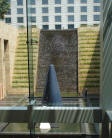 |
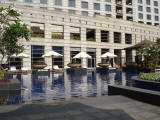 |
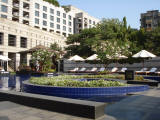 |
| Hyatt | Fountain | Pool | |
 |
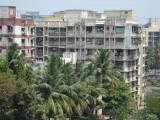 |
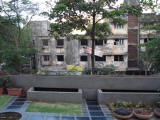 |
 |
| View from my room | and around the hotel |
Sat, Mar 24
I was excited to finally meet my friend and coworker Mandar Walavalkar, who came to the hotel carrying a shopping bag full of wonderful Indian gifts for me. I've been working with Mandar for almost a year, skyping daily and watching his rapid progress as a ChemFinder developer. He's been fun to work with, and as I expected, was a most gracious host and great Mumbai tour guide all weekend.
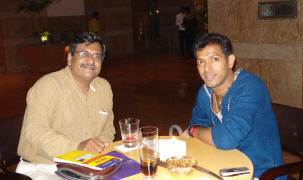 |
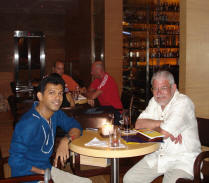 |
| JP and Mandar | Barflies at the Hyatt |
I had a gift for him too. He's a fan of Harley-Davidsons, so when I found out I was going on this trip I built him a model of one. It suffered a little damage in transit, but I smuggled a tube of glue in my suitcase and was able to repair it in the hotel room. Click here for some photos of the project.
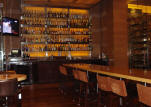 A big event in town on Saturday was an appearance by
Shakira to a packed stadium of belly-dancing fans. I heard she was staying
at the Hyatt same time I was. Didn't see her, no doubt because I spent
more time in the bar than the gift shop.
A big event in town on Saturday was an appearance by
Shakira to a packed stadium of belly-dancing fans. I heard she was staying
at the Hyatt same time I was. Didn't see her, no doubt because I spent
more time in the bar than the gift shop.
Mandar and JP took me out for an evening on the town,
featuring a visit to a brightly-lit festival at the local ISKCON, International
Center for Krishna Consciousness, then dinner at a charming Goan restaurant
(meaning Portuguese-style food from the state of Goa), and a walk on the beach
along the Arabian Sea, crowded with people enjoying the breeze at midnight.
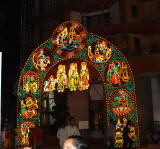 |
 |
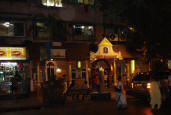 |
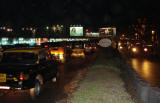 |
|
ISKCON festival |
Face in the crowd | Goan restaurant | Midnight at the beach |
Sun, Mar 25
The Times of India Sunday edition was titled "The Mourning After," because another big event Saturday was a cricket match in which India's World Cup hopes were dashed by a humiliating loss to Sri Lanka. The outcry was deafening. Security details had to be put around players' homes. One fan committed suicide. Apparently cricket brings out some rather non-Indian behavior.
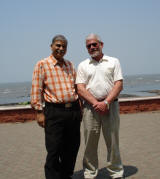 That morning I met Praveen Gupta, CEO of Comtel, after a
year of corresponding by e-mail. Praveen just returned from the US the
night before, but he showed no signs of jet lag as he and Mandar took me on an
all-day driving tour of the city. We cruised in an air-conditioned van
over a lot of ground, past all the tourist spots, tree-lined wealthy
neighborhoods, movie stars' homes by the sea, ornate buildings from the days of
British rule, Muslim mosques, narrow streets crowded with people and lined with
garage-door-sized store fronts, mostly closed on Sunday. I took a lot of
bad pictures from the back seat of the van, and badgered Mandar and Praveen with
questions.
That morning I met Praveen Gupta, CEO of Comtel, after a
year of corresponding by e-mail. Praveen just returned from the US the
night before, but he showed no signs of jet lag as he and Mandar took me on an
all-day driving tour of the city. We cruised in an air-conditioned van
over a lot of ground, past all the tourist spots, tree-lined wealthy
neighborhoods, movie stars' homes by the sea, ornate buildings from the days of
British rule, Muslim mosques, narrow streets crowded with people and lined with
garage-door-sized store fronts, mostly closed on Sunday. I took a lot of
bad pictures from the back seat of the van, and badgered Mandar and Praveen with
questions.
What the postcards show:
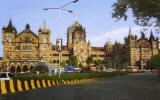 |
|
|
|
Chatrapati Shivaji (formerly Victoria Terminus) |
Prince of Wales Museum |
Western Railway Bldg |
|
|
|
|
|
Dhobi Ghat |
Marine Drive - Queen's Necklace |
Chowpatty Beach |
|
|
|
|
|
Flora of Frere Fountain |
Haji Ali Dargah - Muslim Island Mosque |
Taj Mahal Hotels |
Photos from our tour:
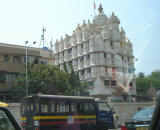 |
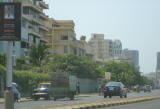 |
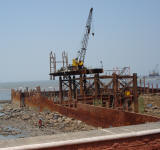 |
 |
| SiddhiVinayak Temple - Temple of Lord Ganesha* | High-rent seaside apartments | Beginnings of a long sea bridge | Beach tough on bare feet |
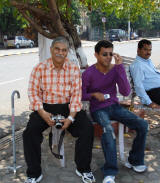 |
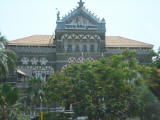 |
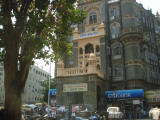 |
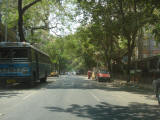 |
|
Praveen & Mandar in the shade |
Sights from the road |
Shady streets downtown |
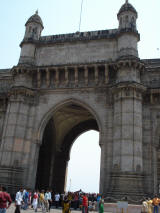 |
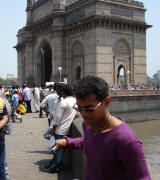 |
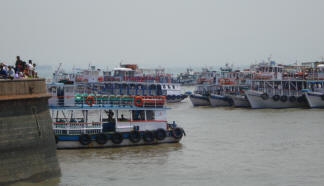 |
| Gateway of India | Built for 1911 visit by King George and Queen Mary | Scenic cruise boats at Gateway |
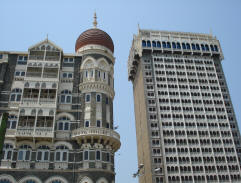 |
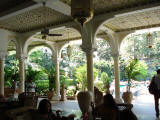 |
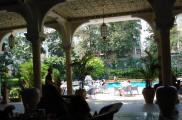 |
|
Old and new Taj Majal Hotels |
Poolside at the old one | |
* Lord Ganesha: God with the head of an elephant, large belly, and four arms, god who eliminates obstacles. Praveen says he is the most intelligent amongst the entire god community.
Lunch was at a place called the Golden Star, featuring vegetarian cuisine from the state of Gujarat. It was a little pub-like place, bustling with young waiters in bare feet and red turbans. Each diner gets a tray of little silver cups, and each waiter is responsible for filling a specific cup -- one comes around with some spicy brown stuff for cup A, another with orange mango soup for cup B, etc.
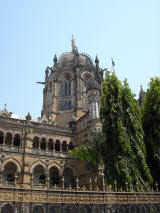 |
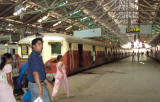 |
 |
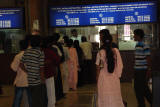 |
| In and around Victoria Station | On a weekday this would be packed | ||
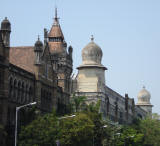 |
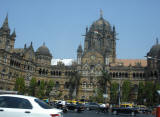 |
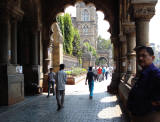 |
 |
| Stray dogs were everywhere |
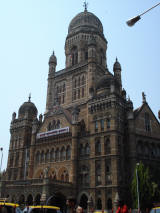 |
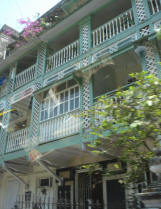 |
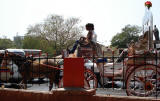 |
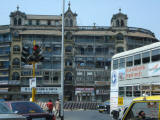 |
The highlight of the weekend was a party given in my honor Sunday evening by Comtel. They rented a room in a lively part of town, and when I walked in I found the entire staff lined up and eager to meet me. I went down the line introducing myself, and spent the evening doing my best to carry on conversations over the background of Indian music, in between sips of beer and bites of the food they kept bringing.
 |
 |
| Aneesh, Subhash, Ramakrishna, Anthony, Raji | Subhash, Raji, et. al. |
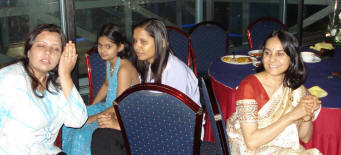 |
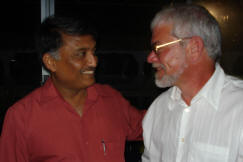 |
| Vaishali, Mandar's niece (Nikita), Supriya, Manju | Vijay and student |
Music was provided by a band featuring sitar, flute, and tabla (a pair of drums like bongos). Each player gave a demonstration of his instrument, and together they spun out a repertoire of classical and popular tunes in haunting and beautiful style. At one point they launched into an up-tempo number, whereupon all the men got up and danced free style with much grinning and arm-waving.
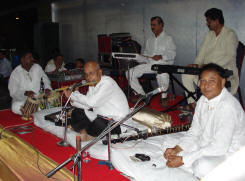 |
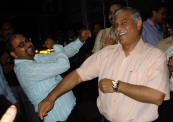 |
 |
|
Tabla, flute, drum pad, keyboard, sitar |
Praveen boogies with the boys (Sunil, Raji, Aneesh) | |
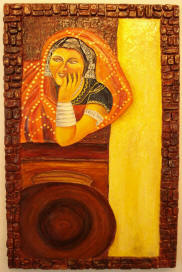 |
After dinner the company officers passed around a
microphone and took turns making welcoming comments, which I answered with an
unpracticed impromptu speech, and then Praveen's wife Manju presented me
with a wonderful painting she had made using oil paints over layers of plaster,
showing a young Indian woman looking mischievously out a window.
Needless to say, I was very honored by the whole event. For more pictures of the event and the Comtel crew, see pictures taken by Praveen. |
|
Manju's painting |
Mon, Mar 26
The Comtel offices are in the new section of town (called Navi Mumbai), in an office park where by government decree all the occupants are in the software business. Comtel has a busy suite of offices in one building, and an empty suite for expansion in another. The buildings themselves are not new, but the offices are, and all the facilities inside are cool and up to date. Unfortunately I waited too long to take a picture of the outside of the building, until it was too dark to get a good one.
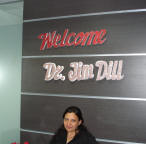 |
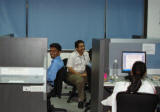 |
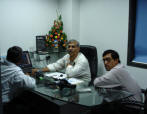 |
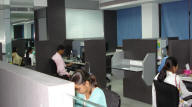 |
| Flattering reception | Aneesh and Raji | Boss's office with JP and Dilip | Development center (Shilpa, Mandar, Priyanka) |
The day was spent in meetings and presentations. I gave an overview of CS, with a bunch of standard corporate slides along with my own personal views of the company. A lunch of veggie burgers was brought in from McDonald's to make me feel at home.
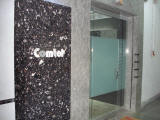 |
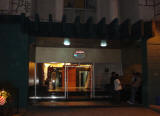 |
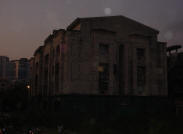 |
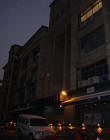 |
| Entry to offices | Building entrance | Across the street | Comtel building |
 Dinner was at a classy restaurant in brand new hotel,
opened just two weeks before. As usual, they just kept bringing yummy
unidentified food items and filling my glass with Kingfisher, the favorite beer
of India.
Dinner was at a classy restaurant in brand new hotel,
opened just two weeks before. As usual, they just kept bringing yummy
unidentified food items and filling my glass with Kingfisher, the favorite beer
of India.
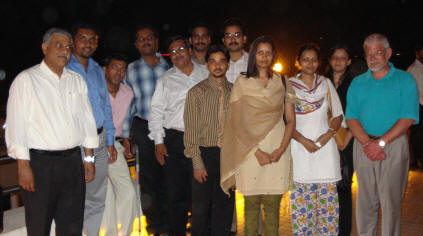 |
| Praveen, Aneesh, Mandar, Subhash, JP, Ramakrishna, Tejas, Raji, Supriya, Priyanka, Vaishali, Honored Guest |
Driving back to the hotel after dinner through the slum area, I saw a woman riding an elephant down the street. Camera was unfortunately not at the ready.
Tues, Mar 27
Tuesday morning I flew to Bangalore on Jet Airways, a top-notch airline with great service. On a 1-1/2 hour flight they served a full hot breakfast. From the air, it looks like there is plenty of open space in the Indian countryside.
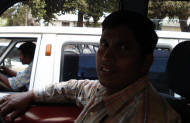 |
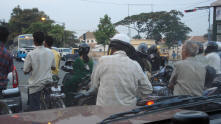 |
| Khalil, amazing Proteans driver | Waiting at stoplight |
On arrival I checked into Hotel Nandhana, called "Bangalore's Finest Business Hotel." This one was not an armed fortress like the Hyatt, but a comfy place in a busy part of town. Wouldn't have suited Shakira, but it was fine for me.
|
|
|
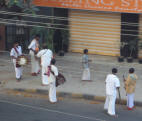 |
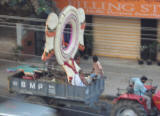 |
| Hotel Nandhana | Reception | A little parade outside my window | |
A few blocks away was the Proteans office where I again gave my CS presentation, and met our new 3-man team of ChemFinder developers -- Ravi, Melvin, and Rahul, all smart, fun, and eager to get going. Lunch was with Ravi and Sudhakar Gorti, CEO of Proteans, at a place where they dispense with the tortillas and you just eat rice by the handful.
I spent the afternoon attempting to do a knowledge dump of ChemFinder architecture, components, work projects, programming techniques, and way too much other data delivered in rambling fashion. The team nodded politely during this disorganized presentation, and agreed to help develop documentation so it'll be easier next time.
 |
 |
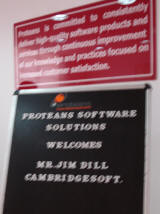 |
| Proteans building | ||
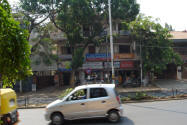 |
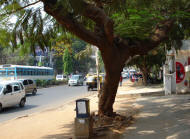 |
| Views along the street | |
That evening Ravi took me on a drive through the city to another ISKCON, this one a huge, ornate temple at the top of Hare Krishna Hill. That night was the birthday celebration of Lord Rama, so the place was full of worshippers, chanting, and incense. No cameras were allowed; you'll have to take my word for it that it was all quite beautiful and mysterious. We peeked at the ceremony, then walked around barefoot on the roof and took in the view of the city lights.
Wed, Mar 28
All of Wednesday was spent at the office, continuing the knowledge dump and getting the development system set up. It took hours to download files, then apply a series of tricks so by day's end we had ChemFinder running in the debugger and ready for bug fixing. Felt like actual tangible accomplishment.
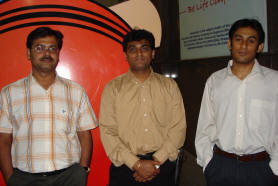 |
 |
|
Rahul, Ravi, Melvin |
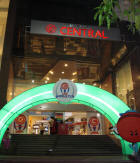 |
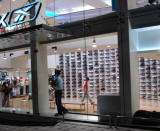 |
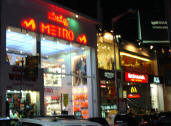 |
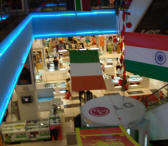 |
| Evening stroll in the Bangalore shopping district | |||
Dinner was at an upscale restaurant called Tandoor, the name referring to a beehive-shaped heating surface where tissue-thin bread is prepared. We watched this process. The cook tosses the dough in the air like pizza and then bakes it quickly on the beehive. Diner consumes it with little dishes of multicolored spicy stuff and mugs of Kingfisher.
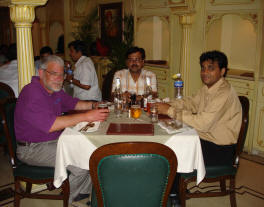 |
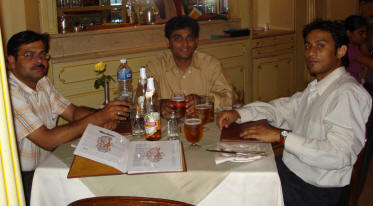 |
|
Dinner at Tandoor |
|
Thurs, Mar 29
The first item on the agenda Thursday was a visit to IBAB, the Institute for Bioinformatics and Applied Biotechnology, a new school in a big campus of high-tech buildings. They are about to introduce a new curriculum for cheminformatics, so we went there to introduce CambridgeSoft and learn about their plans. They asked our advice regarding what they should be teaching, an intriguing question! If we work it right, in the future we may not need to recruit candidates, we may get them trained to our specifications right out of this unique school.
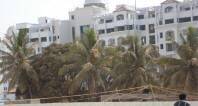 |
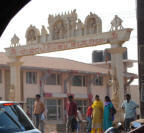 |
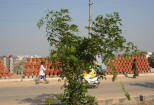 |
 |
| Scenes en route to IBAB | |||
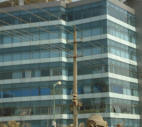 |
 |
 |
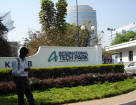 |
| At Tech Park | |||
After that visit we had half an afternoon free, so after a bit of souvenir shopping, Ravi took me for a drive into the countryside. We passed through a couple of little villages, out to a quiet hilltop with a temple and a shady pavilion featuring statues of various gods (including Jesus and Buddha), plus a nice view of Bangalore and surrounding farms of coconut palms.
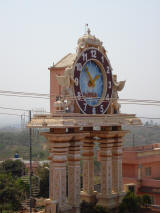 |
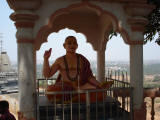 |
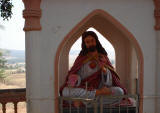 |
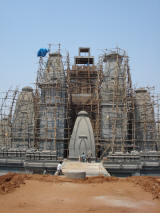 |
| "World's Second Largest Clock Tower" | Featuring six favorite deities | Temple under construction | |
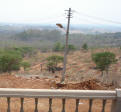 |
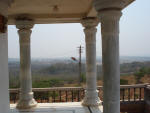 |
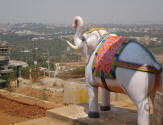 |
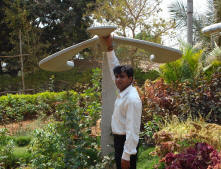 |
| Country views |
Ravi investigates stone bird |
||
There ended the trip. I was delivered to the Bangalore airport at 3 PM, and arrived back in California roughly 34 hours later.
Impressions of India
The guidebooks don't show you pictures of heat, traffic, poverty, dirt, or urban blight, but these are everywhere and I did my best to capture them through the car window. I tried to balance these with pictures of prosperity and technology, which are also everywhere.
Poverty
There are over twelve million people in Mumbai (second largest city in the world, next to Tokyo), and almost 50% of them live in slums. So there are poor people all over the place -- women in saris carrying baskets or bundles of sticks on their heads, pushing heavy carts full of fruits or possessions like big black cooking pots; men squatting in the dirt; boys riding rusty bicycles or motorbikes, sometimes whole families on one bike; children coming up to the car window, looking sad and pointing at their mouths; pickup trucks with a dozen grubby kids in the back; old people walking barefoot along dirt sidewalks.
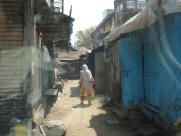 |
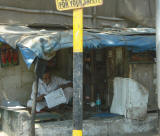 |
 |
| Family making handicrafts on a street island | ||
Many streets are lined with narrow shops, each the size of a single-car garage, often with a dirt floor and nothing inside but a couple of rusty power tools. Typically I saw a couple of men at work in these places, with several others or a group of kids hanging around idly. Along some streets, sidewalks serve as sleeping quarters. It's not uncommon to see a three-block line of bodies stretched out in the open air.
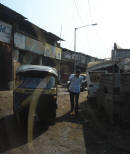 |
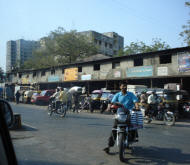 |
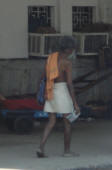 |
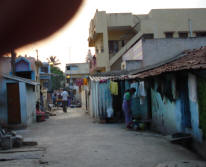 |
 |
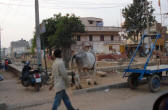 |
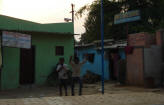 |
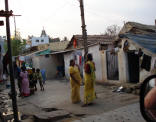 |
It's possible to be poor in India and still get by. In many places there are open-air markets, with vendors selling food or clothing for minimal prices (like ten cents for a shirt). Bus tickets are cheap. Charitable organizations like ISKCON sponsor lunch programs for kids.
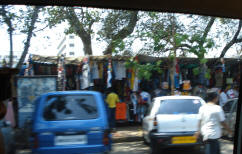 |
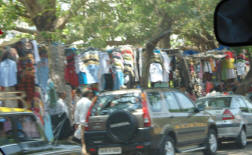 |
|
Outdoor clothes markets |
|
Traffic
The most jarring aspect of life in India is the traffic. It's not just that it's heavy -- any San Franciscan is used to that -- it's that it's so wild and out of control. The average street is jammed with not only cars, trucks, vans, and buses, but also streams of people on foot, bicycles, motorbikes, hand carts, cows, stray dogs, and lots and lots of little cabs: black three-wheel motorbikes with bright yellow vinyl tops, built for a driver and two passengers (but sometimes carrying five or six) which buzz around everywhere like swarms of angry bees.
Your vehicle plows through this river at maximum possible speed, with no regard to lane markers, road signs, or stop lights. If your car is six feet wide and there is a 73-inch gap between the vehicles in front, you zip through it. If you're four inches from the car [bike, pedestrian, cow] in front of you, you move up.
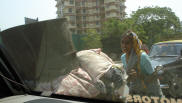 |
 |
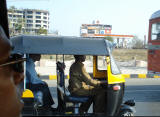 |
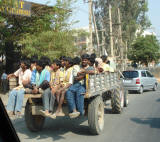 |
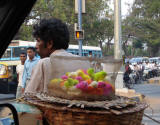 |
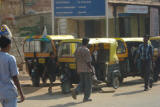 |
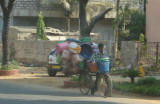 |
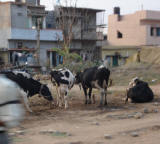 |
Driving is done with one hand on the horn, constantly blasting. In the US, blowing your horn means you're angry at someone. In India, it is the required thing to do to announce your presence behind or near another vehicle. So you pull up to one inch behind some buzzing little cab, blast your horn, the guy moves over an inch, and you blow on past. When you come to an intersection, it's a complete free-for-all: whoever goes first or blows his horn the loudest wins.
Plus: the steering wheel is on the wrong side of the car, and you're driving on the wrong side of the road.
It's like a video game. Or, as I wrote to my wife after a particularly harrowing drive, it's like you're a molecule of water in a fast-moving stream.
 |
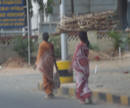 |
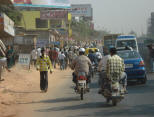 |
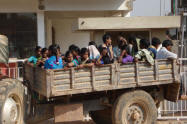 |
The way the natives cope with this is to hire a driver. While I was in Mumbai, Comtel hired a van with driver for four days to shuttle us around. The Comtel CEO has one on permanent staff, and so does Proteans. You hop in the van, talk on your cell phone while the driver navigates the torrents of traffic, and when you arrive, you hop out and it's his problem to go find a parking space. These drivers are young men who command low salaries, yet they do an amazing job of getting from one place to another intact, and they find ways to amuse themselves while you shop, eat, sightsee, or whatever.
Landscape
There are some nice areas in Mumbai and Bangalore, but in most places there are varying degrees of blight, like piles of rubble. dirty, empty lots, abandoned construction sites. In some areas the "streets" are narrow dirt lanes, which must turn into rivers of mud during monsoon season.
 |
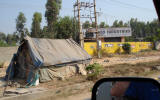 |
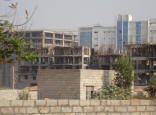 |
 |
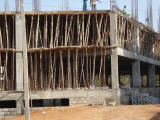 |
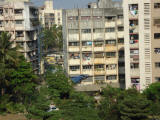 |
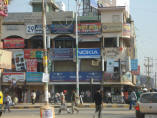 |
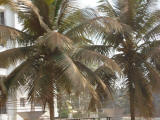 |
Most every building in Mumbai could use a coat of paint. Even the expensive apartment houses look unkept on the outside, mostly because Indians save their money instead of squandering it on what they consider unnecessary expenses, like housing association dues to pay for repainting.
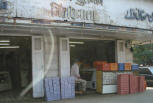 |
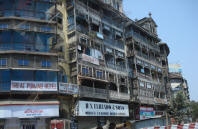 |
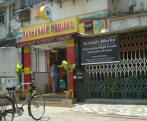 |
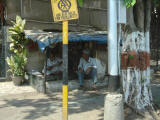 |
Religion
Imagine this: a nationwide religion in which you can pretty much believe whatever you want, and nobody will object or judge you for it. Believe in one God, or many gods; believe God is within you, or is a young man on a chariot. Hinduism is very universal and accepting, and it accommodates a diverse population of spiritual people.
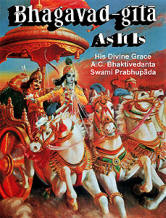
 The principal book of the Hindus is called the
Bhagavad-Gita, a volume of ancient Sanskrit writings translated and interpreted
by His Divine Grace, A. C. Bhaktivedanta Swami Prabhupada. Mandar gave me
a copy of this book and I've been trying to figure it out. The first part
describes a battle which occurred five thousand years ago, and relates profound
exchanges between Lord Krishna and his disciple Arjuna. Later parts
discuss yoga, meditation, rules for living, tidbits of wisdom from Lord Krishna,
and other aspects of the "science of self-realization."
The principal book of the Hindus is called the
Bhagavad-Gita, a volume of ancient Sanskrit writings translated and interpreted
by His Divine Grace, A. C. Bhaktivedanta Swami Prabhupada. Mandar gave me
a copy of this book and I've been trying to figure it out. The first part
describes a battle which occurred five thousand years ago, and relates profound
exchanges between Lord Krishna and his disciple Arjuna. Later parts
discuss yoga, meditation, rules for living, tidbits of wisdom from Lord Krishna,
and other aspects of the "science of self-realization."
It's all very dense and mysterious, but it seems to work -- faith and spiritualism are what get half a billion people through the day.
Weather
The weather was nice during the trip. In Mumbai it got fairly warm during the day, but not impossibly hot, no worse than Oklahoma or Boston in the summer, and of course cars and offices are air-conditioned. But this is the start of summer, so it will continue to get hotter until reaching a maximum around May or June.
In the fall comes the monsoon. For a few months, it rains every day, hard. Streets turn into rivers, dirt turns into mud, and traffic becomes an even worse nightmare.
Bangalore is not that far away, but is at a higher elevation so the weather is more pleasant -- days are not too hot, evenings are breezy and balmy, and evidently it is that way most of the year.
Food
Indians are fond of eating, and even more fond of telling newcomers how every state has its own particular sort of cuisine. I was not able to distinguish between Mumbai and Bangalore dishes, since to me every meal was a whole new experience, but any native can tell you which states favor coriander over cumin.
Eating a typical Indian meal is done as follows. Along with various multicolored dishes, you get a plate of tortilla-like things made of wheat or rice. One hand stays in your lap. With the other, you tear off a little piece of a tortilla and use it to convey the stuff from a dish to your mouth. Forks are not involved. Fingers get messy. Indians are efficient at this process, so they always finished and were tidying up in their finger bowls while I still had mounds of food and was trying to figure out how to tear a piece off a tortilla with one hand.
People
The people in India are among the most hospitable in the world. Low-paid workers in the hotels and shops are friendly and respectful. My hosts dropped everything they were doing while I was there, and concentrated on my well being. Their religion says that if a guest comes to visit, they are to treat him as if God had dropped in. I felt this from everyone, and I missed it as soon as I stepped off the plane at JFK and faced the surly, uncaring customs agents.
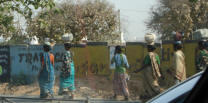 |
 |
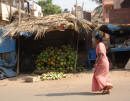 |
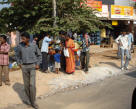 |
We could learn a lot from the Indians. They're not loud, pushy, or demanding. What life deals them, they tolerate without complaint (except possibly for certain cricket fans). They know how to make money (there are more billionaires in India than any other country in Asia, including China and Japan), but their lives do not revolve around it, and if they don't have enough, they work with what they have and don't obsess about it.
The main thing I realized is that, unlike Americans, Indians do not have our sense of entitlement. We insist that society owes us this or that, and if we don't get it, we throw tantrums. They don't. They help each other, but they don't expect or demand anything from the government or the neighbors.
